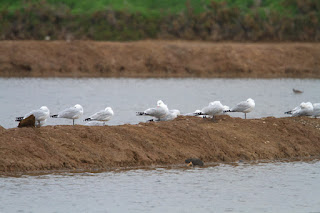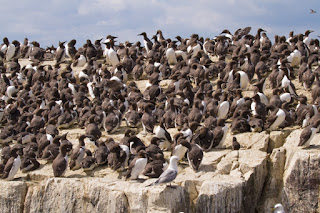We helped out with the monthly count of wetland birds at Castro Marim on Monday. In addition to the Cerro do Bufo area and Sinexpral, we also covered the Esteiro da Carrasqueira with the whole count taking four of us almost four hours. Cerro do Bufo is a huge area which held close to 3,000 birds. Counting them without disturbing them is a challenge and on this occasion we weren’t help by the presence of a couple of Marsh Harriers, an Osprey and a Peregrine Falcon that caused panic among the ducks and waders whenever they appeared. The Shelducks were particularly flighty and we have to admit that our total count of 364 might not be the most accurate.
Osprey
Greater Flamingos (700) were the most numerous species; there were 18 wader species, seven duck species; 112 Cormorants and 70 Black-necked Grebes. A single Great Egret was the nearest we came to seeing anything unusual.
Black-necked Grebes
At Sinexpral we found around 1,300 birds more than half of which were Dunlins; there were about a dozen Curlew Sandpipers amongst them. In fact there were more than ten times more Dunlin here than there had been at Cerro do Bufo and lots more Ringed & Kentish Plovers, a pattern we have seen before.
Easily the most numerous species of the day were the Eurasian Coots on the Carrasqueira, about 900 of them. On another day we might have searched through them for a Red-knobbed bird but we have to be in the right mood for that sort of thing and this wasn’t the time. About a dozen each of Great Crested & Little Grebes were with them plus just a handful of ducks and gulls.
Great Crested Grebe
As well as Marsh Harriers and Peregrine Falcon we saw an Osprey, a Sparrowhawk, a Common Buzzard and a Common Kestrel – a six raptor day! The following day at Quinta do Ludo we beat this with seven raptor species. These included a Black-winged Kite, a Hen Harrier and no fewer than ten Booted Eagles.
Black-winged Kite
We always enjoy Ludo but for some reason on Tuesday it wasn’t at its best. There was a marked lack of waders on the saltpans and an almost complete lack of ducks on the Ribeira de São Lourenço.
Thankfully, when we reached the lagoa de São Lourenço it was a different story - there were lots of birds to sort through and to photograph in the really nice afternoon light. On the way there, we saw a Water Pipit, which wasn’t unexpected and a Woodcock, a species we see only rarely which was certainly a surprise! Unfortunately, the Woodcock was dead by the roadside, probably hit by a car.
Eurasian Wigeon
Lagoa de São Lourenço is well-known as a place to see Little Bitterns and although this is a species that is considered to be a trans-Saharan migrant, it’s usually possible to find them here through the winter. Today we saw three different birds.
Of course, this is one of the best sites in the Algarve to get close to and to photograph various common duck species and also Western Swamp-hens (a name, incidentally, we are still struggling to get used to). Glossy Ibis and Black-headed Weaver are species that we expect to find here and in recent times we have regularly seen Water Rails.
Western Swamp-hen
Hoopoes are fewer here in winter but can usually be found on the neighbouring golf course, which is also the favoured feeding area for Mistle Thrushes.
Hoopoe
Mistle Thrush
We got our required wader fix first of all in the Ria Formosa at Praia de Faro and later, on the way home, at saltpans near Olhão. We often find a few Knots here and on this occasion were able to more or less walk up to one for a photograph. This is also a regular place to find Slender-billed Gulls and we weren’t disappointed.
Olhão saltpans
Red Knot
We finished the week with a trip west to Sagres and this turned out to be another six raptor day with Short-toed Eagle and Red Kite amongst them bringing the total of raptor species for the week up to eleven.
Short-toed Eagle
This was planned to be mainly a photography day and we hoped to find Alpine Accentors, Rock Pipits, Ring Ouzels and Purple Sandpipers. As it was we had to settle for Cormorants, Black Redstarts, Thekla Larks and other more common species but had an enjoyable day in spite of that.
Great Cormorant
Black Redstart
In fact we had a very pleasant week, dodging the worst of the weather and enjoying a great variety of birds.




































































